First in London I think it was cows. Then elephants and doubtless other animals cluttering up the pavements of our city. In Berlin it’s bears, which at least are appropriate, as the bear has been adopted as the symbol of Berlin, probably because of the similarity between their names.
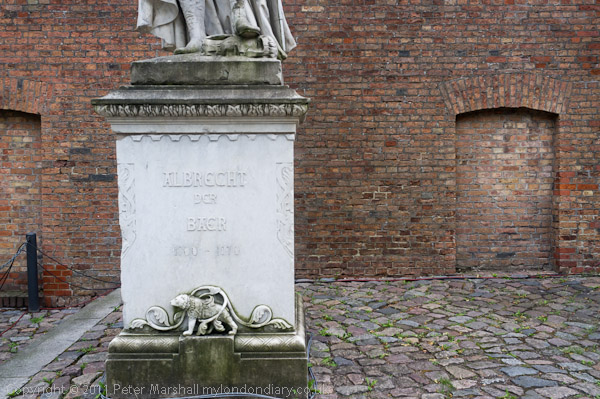
Albrecht de Baer at Spandau Fortress
So Berlin is always full of bears, but there is an extra load of them at the moment. The first ‘Buddy Bears’ which populated Berlin in 2001 simply promoted these 2 metre high fibreglass animals as a little urban fun for the city. Then in 2002 came the ‘United Buddy Bears’, (UBB) a kind of united nations assembly of these figures designed to promote harmony, tolerance and understanding among different nations, cultures and religions.
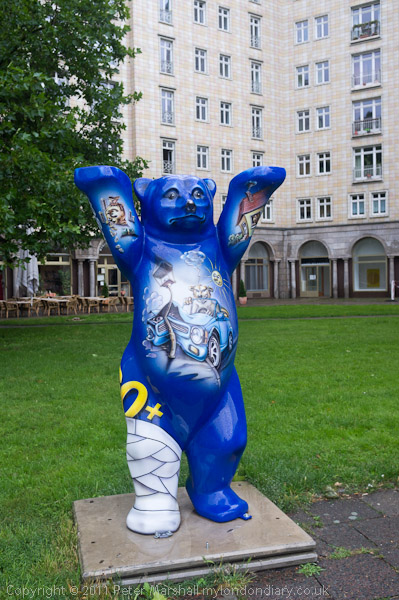
Our first Berlin Buddy Bear sighting was on Karl Marx Allee
It’s an idea that brings out the cynic and the realist in me, seeing it as yet another way for people and in particular large corporations that sponsor such things to feel good and look good to the people without actually doing anything to solve the very real problems that the world faces. Getting artists from countries around the world to decorate a few bears doesn’t do much for world peace, global warming and moving towards a new and sustainable global economy. It’s just a bright and happy little circus, though it has raised quite a considerable sum for UNICEF and childrens’ charities over the years.
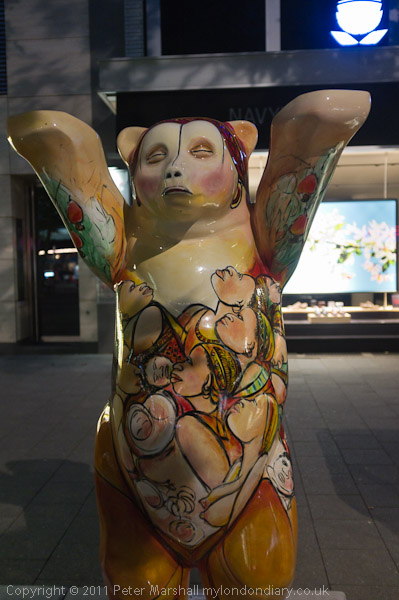
Since Rome is burning we might as well enjoy the violin playing, and the bears are rather fun in a way, some rather cleverer than others. As well as being scattered around the city there is also for the next few months a complete set – one for each of over 140 countries and a few ‘specials’ – along the edges of the Kurfürstendamm. Earlier in the day that I photographed the UBB I’d strolled along with the crowds looking at the images in the display at the Topographie des Terrors (Topography of Terror) where images and text described the Nazi pogroms against Jewish shops and businesses culminating in the infamous Kristallnacht or Night of Broken Glass in 1938. Jewish owned businesses on the Ku’damm had been closed by the police three years earlier.
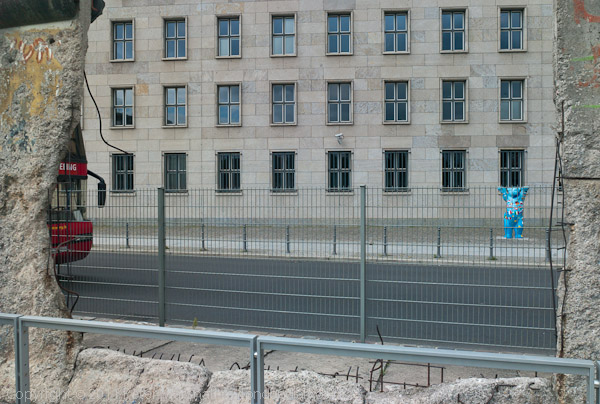
A bear seen through a gap in the Wall at the Topographie des Terrors
Now at night the Ku’damm is largely closed and dead in any case, the fashion stores (a kind of living death by day) shutting their doors early and the cafes and cinemas now largely gone after Berlin life moved back closer to the city centre when the wall came down. It’s wide, full of chestnut trees and poorly lit by London standards, and most of that light was coming from shop windows, shining from behind the bears making photography a little tricky.
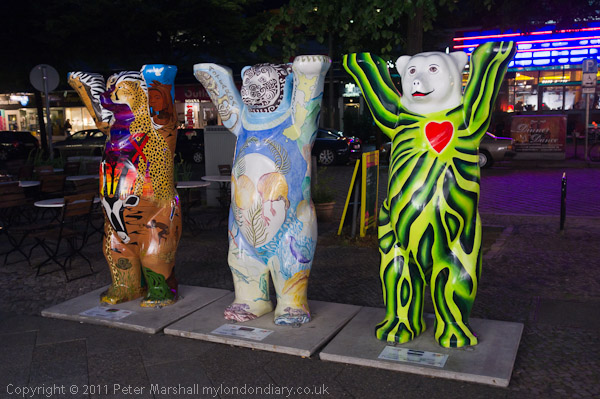
I put away the Leica M8, a hopeless performer in poor light even with the f1.4 35mm lens and hardly usable in colour above ISO640, and relied solely on the Fuji FX100. Reviewers tell me it is slow to focus in low light, but the bears weren’t moving and I had few problems. Almost all the pictures were at full aperture (f2) and shutter speeds varied from1/13 to 1/80.
Generally even wide open there was enough depth of field and of course more than would be got on a full frame camera. With the actual 23mm lens (35mm equiv) on the FX100 focussed at 3.0 metres things should be sharp from 2.45 to 3.87 m according to the on-line DOFMaster calculator. With a true 35mm lens on full frame you have to stop down to f2.8 to get similar figures.
The Leitz 35mm f1.4 is a decent fast standard lens (45.5 mm equiv), but for similar DOF you need to stop down to f4, while a standard lens on full frame would have to be closed down to f6.4. Unfortunately the 21mm f4 Voigtlander lens I have (27mm equiv) although a very useful focal length is a little slow for low light.
So when working with smaller sensors you can take advantage of wider apertures, and the same is also true with wide-angle lenses. Put the two together and with the 23mm f2 of the FX100 you can work at full aperture should you wish to much of the time. There is however a slight improvement in sharpness on stopping down to F2.8 and probably f4, and of course there are times when you do want greater depth of field. But the point is you need to think about apertures rather differently than we used to when working with smaller sensors.
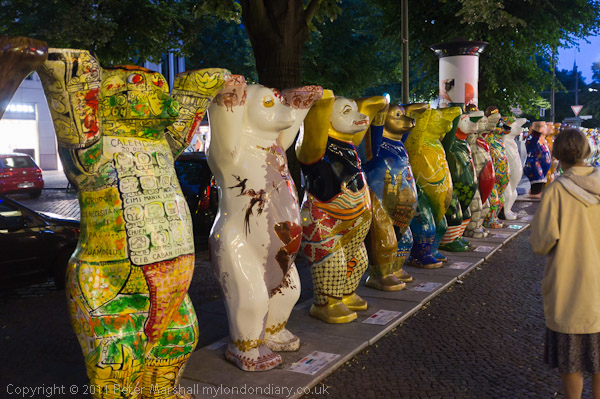
In fact the figures understate the difference in practice. This long line of bears (above) is actually acceptably sharp (at f2.0) from the closest bear more or less to the end of the line.
I was working at ISO 1600, though when the light got really low I should perhaps have switched to ISO3200 and possibly tried out . I was working without flash, and there was a great deal of light in the shop windows behind the bears and very little on their fronts and faces, which were underexposed by a stop or two (and most were taken with exposure compensation set at -1) and need some coaxing in Lightroom while the bright backgrounds have to be brought down considerably. There is quite a lot of noise in these images, but it isn’t unpleasant and there is still plenty of detail. It’s still quality we would have sold our souls for in the days of film, though Alamy QC might beg to differ.
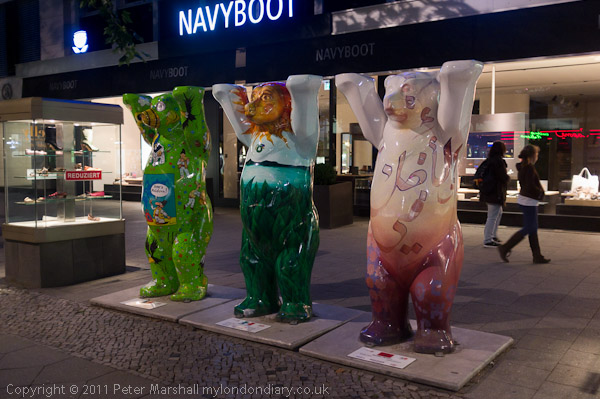
The main problem I had was that once started it was seriously addictive and I had to photograph them all. Even though a few were lost to camera shake or incorrect focus I now have enough pictures of the beasts to make my Berlin holiday snaps a case of bear-dom boredom. Though there is a cow and an elephant too.